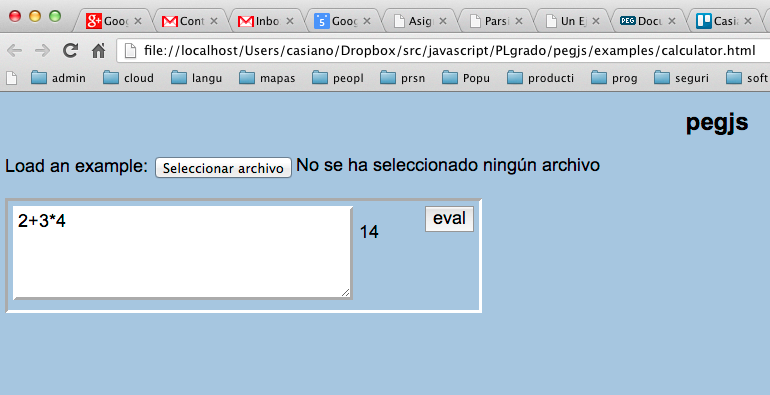

Sig: Eliminación de la Recursividad Sup: Análisis Descendente mediante Parsing Ant: Acciones Intermedias Con:
~/srcPLgrado/pegjs/examples(master)]$ pwd -P /Users/casiano/local/src/javascript/PLgrado/pegjs/examples
[~/srcPLgrado/pegjs/examples(master)]$ git remote -v dmajda https://github.com/dmajda/pegjs.git (fetch) dmajda https://github.com/dmajda/pegjs.git (push) origin git@github.com:crguezl/pegjs.git (fetch) origin git@github.com:crguezl/pegjs.git (push)
[~/Dropbox/src/javascript/PLgrado/jison]$ pegjs --help
Usage: pegjs [options] [--] [<input_file>] [<output_file>]
Generates a parser from the PEG grammar specified in the <input_file> and
writes it to the <output_file>.
If the <output_file> is omitted, its name is generated by changing the
<input_file> extension to ".js". If both <input_file> and <output_file> are
omitted, standard input and output are used.
Options:
-e, --export-var <variable> name of the variable where the parser object
will be stored (default: "module.exports")
--cache make generated parser cache results
--track-line-and-column make generated parser track line and column
-v, --version print version information and exit
-h, --help print help and exit
Le indicamos que el parser se guarde en calculator:
[~/Dropbox/src/javascript/PLgrado/pegjs/examples(master)]$ rake web ../bin/pegjs -e calculator arithmetics.pegjs
[~/srcPLgrado/pegjs/examples(master)]$ head -5 arithmetics.js
calculator = (function() {
/*
* Generated by PEG.js 0.7.0.
*
* http://pegjs.majda.cz/
calculator:
[~/srcPLgrado/pegjs/examples(master)]$ cat calc.js
$(document).ready(function() {
$('#eval').click(function() {
try {
var result = calculator.parse($('#input').val());
$('#output').html(result);
} catch (e) {
$('#output').html('<div class="error"><pre>\n' + String(e) + '\n</pre></div>');
}
});
$("#examples").change(function(ev) {
var f = ev.target.files[0];
var r = new FileReader();
r.onload = function(e) {
var contents = e.target.result;
input.innerHTML = contents;
}
r.readAsText(f);
});
});
[~/Dropbox/src/javascript/PLgrado/pegjs/examples(master)]$ cat arithmetics.pegjs
/*
* Classic example grammar, which recognizes simple arithmetic expressions like
* "2*(3+4)". The parser generated from this grammar then computes their value.
*/
start
= additive
additive
= left:multiplicative PLUS right:additive { return left + right; }
/ left:multiplicative MINUS right:additive { return left - right; }
/ multiplicative
multiplicative
= left:primary MULT right:multiplicative { return left * right; }
/ left:primary DIV right:multiplicative { return left / right; }
/ primary
primary
= integer
/ LEFTPAR additive:additive RIGHTPAR { return additive; }
integer "integer"
= NUMBER
_ = $[ \t\n\r]*
PLUS = _"+"_
MINUS = _"-"_
MULT = _"*"_
DIV = _"/"_
LEFTPAR = _"("_
RIGHTPAR = _")"_
NUMBER = _ digits:$[0-9]+ _ { return parseInt(digits, 10); }
[~/srcPLgrado/pegjs/examples(master)]$ cat calculator.html
<!DOCTYPE HTML>
<html lang="en">
<head>
<meta charset="utf-8">
<title>pegjs</title>
<link rel="stylesheet" href="global.css" type="text/css" media="screen" charset="utf-8" />
</head>
<body>
<h1>pegjs</h1>
<div id="content">
<script src="https://ajax.googleapis.com/ajax/libs/jquery/1.10.2/jquery.min.js"></script>
<script src="arithmetics.js"></script>
<script src="calc.js"></script>
<p>
Load an example:
<input type="file" id="examples" />
</p>
<p>
<table>
<tr>
<td>
<textarea id="input" autofocus cols = "40" rows = "4">2+3*4</textarea>
</td>
<td class="output">
<pre>
<span id="output"></span> <!-- Output goes here! -->
</pre>
</td>
<td><button id="eval" type="button">eval</button></td>
</tr>
</table>
</p>
</div>
</body>
</html>

Casiano Rodríguez León